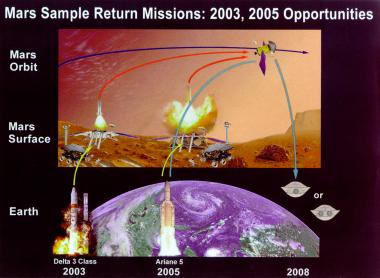IntroductionIn the year 2003, just two years from now,
NASA, in conjunction with French and Italian colleagues, will embark on one of
the most exciting missions yet undertaken in the exploration of space: the return
of samples from Mars. The mission
(Figure 1) will consist of two separate launches (‘03 and ‘05), each of which
will conduct experiments on the surface of Mars, retrieve and store samples,
and put these collected samples into Mars orbit in two separate sample
canisters. In 2005 a Mars orbiter will
be launched to retrieve both samples, and return them to Earth for scientific
analyses. In 2008, the samples of rock
and soil will return to Earth (a total of 1-2 kg) for scientific study. These samples will add an immense amount to
our knowledge of the solar system, and of Earth itself, and will also be
carefully scrutinized for the presence of indicators of present or past life on
the red planet. Given the absence of
any obvious features on Mars that suggest life, and the negative results (with
regard to life) obtained in the Viking mission of the 1970, In essence, the results of recent scientific inquiry in several areas provide the basis for increased optimism for finding life elsewhere in the universe, and if we are going to launch such a search: our nearby neighbor, Mars, is a reasonable first step. With regard to new knowledge: 1) we have learned things about the universe that have made the search for extraterrestrial life much more reasonable; and 2) our understanding of life on Earth has changed dramatically, altering our view of our own planet’s biota, and therefore the possibility that life might exist on places previously regarded as too hostile for life. While the astronomical discoveries (new suns, new planets, new information about the structure and history of Mars, the purported ocean on Europa, etc.) are important, it is the “lessons from the Earth” that I will concentrate on here.
Figure 1: Architecture of the Mars Sample Return Mission. As currently planned, the Mars Sample return mission will consist of two launches, one in 2003 with a lander and rover, and a second one in 2005, with a similar lander, rover, and orbiter (Earth Return Vehicle). After landing on the Mars surface, the rover will collect samples (consisting of cores of both rocks and soil), and return these samples to a small cache in a rocket on the lander. These samples will be placed in a small sphere (orbiting cylinder or OS), and put into Mars Orbit, so that after the 2005 mission, there will be two small ‘satellites” orbiting Mars. The Earth Return Vehicle will enter Mars orbit, retrieve the samples, and return them to Earth for analysis. As the project scientist for the upcoming sample return mission, I was surprised and delighted to be asked to contribute to this symposium on science and religion. The connection with the purported conflict between these two areas is not at all obvious for a microbiologist interested in the early evolution of the Earth and its biota. From my perspective, both of these endeavors were possible only after humankind developed to a point that we had the honor and pleasure to practice science and to contemplate our own destiny, ethics and morality. Thus, for most of the Earth’s history our planet was dominated by life that had nothing to do with either science or religion - it really could have cared less! To this end, I believe it is appropriate to begin my presentation with our current view of life’s history on our own planet, keeping in mind that any search for life elsewhere must be framed by our knowledge of the history of life on Earth. In its early life-compatible stages, the Earth was still a fairly hostile spot for life as we know it now. It was warm, lacked oxygen in its atmosphere, and because of the lack of oxygen, had little ozone to protect the planet from harmful ultraviolet light. Yet, it was in such an environment that life arose and left its earliest records. From recent studies of the Issua formation in Greenland, traces of metabolic activity (carbon metabolism) indicate that life existed on Earth as early as 3.8 Ga (billion years ago). This suggests that the invention of life took place rather rapidly, roughly within 200 million years of when the planet cooled and thereby became hospitable for carbon-based life. These discoveries have triggered speculation about life in general
(e.g., the problems associated with the invention of complex living systems),
as well as about the possibility that similar living systems might have evolved
on other planets. For example, it is
generally agreed that in the early period of planetary development, and up
until about 3.5 Ga, Mars and Earth may have shared similar planetary
conditions.
Contributed by: Dr. Kenneth Nealson |






